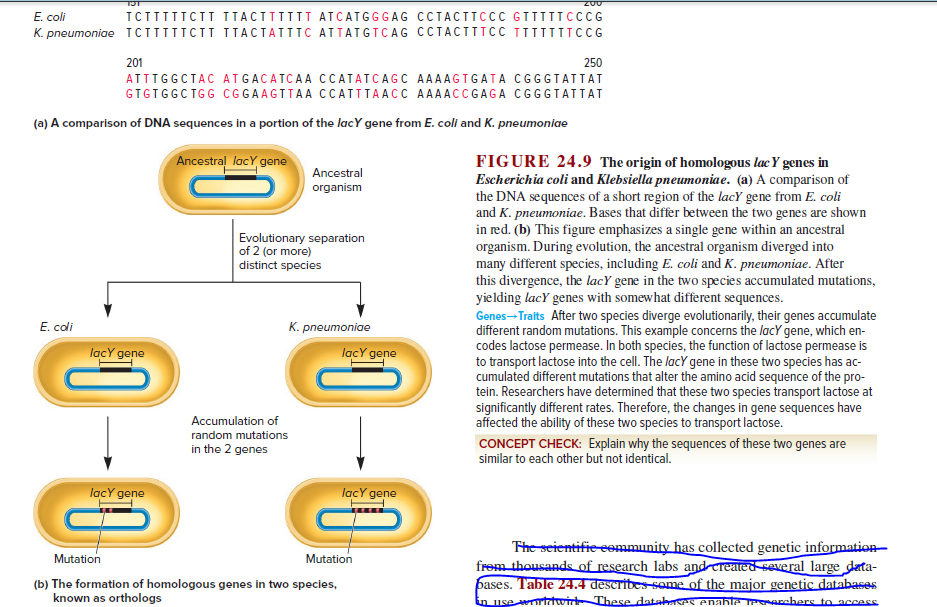TOT E. coli TCTTIIICTT тТАСTTTTTT AтСATGGGAG CCТАСТТССС GTTTTTCCCG K. pneumoniae TCIIIIICII IACTATIIC ATTAIGICAG CCTACTIICC TIIIIIICCG 201 250 ATTIGGCTAC ATGACATCAA CCATAICAGC AAAAGTGATA CGGGTAITAI GIGTGGC TGG CGGAAGTTAA CCATITAACC AAAACCGAGA CGGGTAITAI (a) A comparison of DNA sequences in a portion of the lacY gene from E. coli and K. pneumoniae Ancestral lacY gene FIGURE 24.9 The origin of homologous lac Y genes in Ancestral Escherichia coli and Klebsiella pneumoniae. (a) A comparison of the DNA sequences of a short region of the lacY gene from E. coli and K. pneumoniae. Bases that differ between the two genes are shown in red. (b) This figure emphasizes a single gene within an ancestral organism. During evolution, the ancestral organism diverged into many different species, including E. coli and K. pneumoniae. After this divergence, the lacY gene in the two species accumulated mutations, yielding lacY genes with somewhat different sequences. Genes-Traits After two species diverge evolutionarily, their genes accumulate different random mutations. This example concerns the lacY gene, which en- codes lactose permease. In both species, the function of lactose permease is to transport lactose into the cell. The lacY gene in these two species has ac- cumulated different mutations that alter the amino acid sequence of the pro- tein. Researchers have determined that these two species transport lactose at significantly different rates. Therefore, the changes in gene sequences have affected the ability of these two species to transport lactose. CONCEPT CHECK: Explain why the sequences of these two genes are similar to each other but not identical. organism Evolutionary separation of 2 (or more) distinct species E. coli K. pneumoniae lacY gene lacY gene Accumulation of random mutations in the 2 genes lacY gene lacY gene The seientifie eemmunity has collected genetic information- frem thousands of research labs and created-several large deta- þases. Table 24.4 describes some of the major genetic databases Mutation Mutation (b) The formation of homologous genes in two species, known as orthologs in use wiriwir These datakAS enable Parchers to access
Structure and Composition of Cell Membrane
Despite differences in structure and function, all living cells in multicellular organisms are surrounded by a cell membrane. Just like the outer layer of the skin separates the body from its environment similarly, the cell membrane, also known as 'plasma membrane,' separates the inner content from its exterior environment.
Cell Membrane
The cell membrane is known by different names like plasma membrane or cytoplasmic membrane, or biological membrane. The term "cell membrane" was first introduced by C. Nageli and C. Cramer in the year 1855. Later on, in 1931, the term "plasmalemma" for cell membrane was given by J. Plowe. The cell membrane separates the cell's internal environment from the extracellular space. This separation allows the protection of cells from their environment.
Prokaryotes vs Eukaryotes
The cell is defined as the basic structural and functional unit of life. The cell membrane bounds it. It is capable of independent existence.
Explain why the sequences of these two genes are similar to each other but not identical.

Trending now
This is a popular solution!
Step by step
Solved in 2 steps




